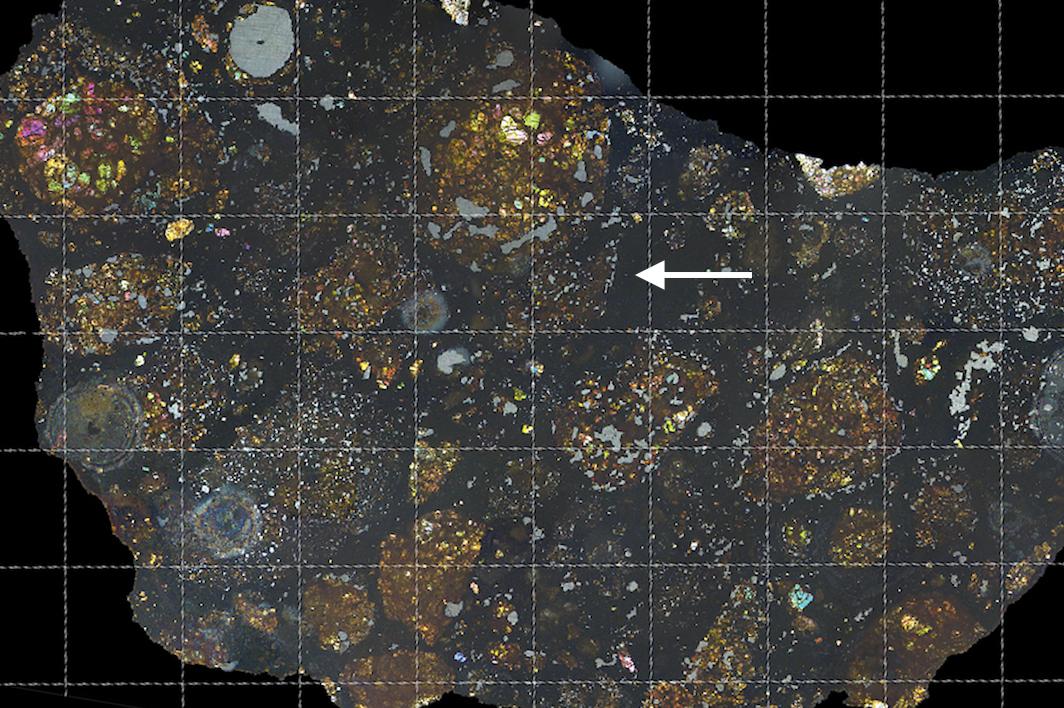Rare Comet Fragment Found Inside Rocky Meteorite
The delicate fragment raises questions.

Our perception of the early solar system just got warped. Researchers have found a piece of a comet — an object made up of ice and dust — inside of a space rock known as a stony meteorite.
Researchers made the strange find in a meteorite that smacked down in Antarctica's LaPaz Icefield, a popular location for people hunting for space rocks. Embedded inside the meteorite was a carbon-rich dust particle that looks very similar to those already seen in comets, researchers said in a statement.
The find is interesting because comets and meteorite parent bodies (also known as asteroids) can originate in very different areas of the solar system. Both types of small worlds came from the large collection of gas and dust available in the young solar system, around 4.5 billion years ago. Comets tend to form far out in the solar system, away from the sun's heat, where ice resides, while asteroids are made of tougher stuff and can form just about anywhere.
Related: More Comet Samples Needed to Understand Solar System's History, Scientists Say
Meteorites occur when pieces break off larger space rocks and plunge through Earth's atmosphere before slamming into the planet's surface. (As it's burning up, it's called a meteor — only if some part makes it down is it called a meteorite.) Most of a meteorite's material does get burned away before making it all the way down, making the comet dust find superspecial for scientists.
"I knew we were looking at something very rare," Arizona State University research scientist Jemma Davidson, a co-author on the new work, said in the statement. "It was one of those exciting moments you live for as a scientist."
Analysis of the LaPaz meteorite suggests that this dust fragment was captured very early in the solar system's history, only 3 million to 3.5 million years after the sun was formed. Further chemical and elemental studies suggested that the dust particle probably came from the Kuiper Belt, a region of icy objects beyond Neptune's orbit where many comets come from.
Get the Space.com Newsletter
Breaking space news, the latest updates on rocket launches, skywatching events and more!
A close study of this meteorite will reveal some clues about the early solar system's formation. For example, this dust particle probably got inside the meteorite because it migrated from the Kuiper Belt to the region near Jupiter, where carbonaceous chondrite asteroids like the parent of the LaPaz meteorite formed. Carbonaceous chondrites formed early in the solar system's history and their meteorites are among the rarest types found on Earth.
"Because this sample of cometary building block material was swallowed by an asteroid and preserved inside this meteorite, it was protected from the ravages of entering Earth's atmosphere," the study's lead author, Larry Nittler, a cosmochemist at Carnegie University, said in the same statement. "It gave us a peek at material that would not have survived to reach our planet's surface on its own, helping us to understand the early solar system's chemistry."
A paper based on the research was published April 15 in the journal Nature Astronomy.
- Meteorite Studies Reveal Surprises About Earth's Formation
- How Often do Meteorites Hit the Earth?
- Rock Found by Missouri Farmer Is Rare Meteorite
Follow Elizabeth Howell on Twitter @howellspace. Follow us on Twitter @Spacedotcom and on Facebook.
Join our Space Forums to keep talking space on the latest missions, night sky and more! And if you have a news tip, correction or comment, let us know at: community@space.com.

Elizabeth Howell (she/her), Ph.D., was a staff writer in the spaceflight channel between 2022 and 2024 specializing in Canadian space news. She was contributing writer for Space.com for 10 years from 2012 to 2024. Elizabeth's reporting includes multiple exclusives with the White House, leading world coverage about a lost-and-found space tomato on the International Space Station, witnessing five human spaceflight launches on two continents, flying parabolic, working inside a spacesuit, and participating in a simulated Mars mission. Her latest book, "Why Am I Taller?" (ECW Press, 2022) is co-written with astronaut Dave Williams.









